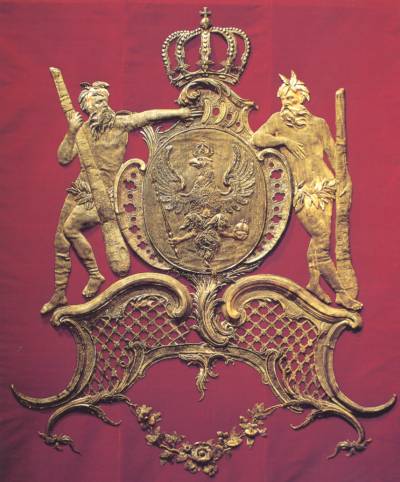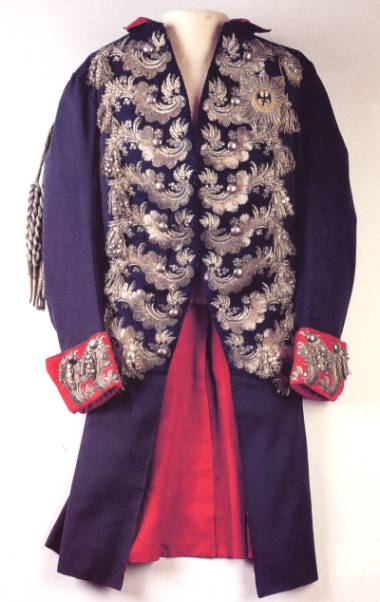
coat
of arms in gold embroidery for throne,
by Mathias Immanuel Heynitschek,
Berlin around 1750

uniform,
Berlin around 1785,
Deutsches Hist. Mus. Berlin, Inv.Nr. U 59.5
| ANNE WANNER'S Textiles in History / book reviews, articles |
| Berliner Goldsticker
im friderizianischen Rokoko, by Uta-Christiane
Bergemann, in: Jahrbuch 1999/2000, Stiftung Preussische
Schlösser und Gärten Berlin-Brandenburg, p. 33 - 64,
Berlin 2002, 6 b/w photos (No 1-6), 8 colour pictures
(table 8-15), in german ISBN 3-05-003716-4, Akademie Verlag GmbH, Berlin 2002 see also: |
coat
of arms in gold embroidery for throne, |
uniform,
Berlin around 1785, |
| During the reign of Frederik
2nd of Prussia, textiles with gold and silver embroidery
played an important role. They served as a visual
demonstration of might of the new Prussian Monarchy. Only the members of the court and noblemen were allowed to wear gold embroideries. This precious ornamentation were used on representative objects like coaches, thrones, saddles and harnesses. In the rooms embroideries were used for wall tapestries, on furniture, beds, table cloths and so on. In this present article, Ute
Christiane Bergemann deals with some very interesting
documents on gold embroidery. She found several sources
where names of gold embroiderers are mentioned. In two
descriptions by contemporary authors gold
embroiderers are named as well: Other important documents are the Berlin
Address books. In the years from 1746 to 1784
there exists a rubric with exceptionally important
addresses. Moreso there are the inventories of castles
and the account books of the court. Other workshops in Berlin which delivered mainly for
noblemen were: Other gold embroiderers were: Johann
Andreas Barth, Johann Christian Barth, Christian Grand,
Johann Friedrich Kolbe, Christian Wilhelm Kolbe, Johann
Heinrich Ranspach, Carl Friedeberg, Frantz Friedrich
Puppach, George Gottlieb Discher, Andreas Fehrmann,
Hurlin, Carl Ludewig Morisson, ans Jean Barez from
Amsterdam is found in Berlin since 1724. The gold and silver threads were delivered by the Berlin Gold and Silver manufactory at Wilhelmsplatz in Berlin. This enterprise employed more than 800 workmen. |
| home content | Last revised May 7, 2004 | For further information contact Anne Wanner wanner@datacomm.ch |